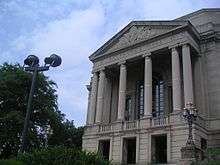Walker and Weeks
Walker and Weeks was an architecture firm based in Cleveland, Ohio, founded by Frank Ray Walker (1877-1949) and Harry E. Weeks (1871-1935).
Background
Both men studied at MIT, where they received training in the Beaux-Arts tradition of classical design. They moved to Cleveland to work for the prominent Cleveland architect J. Milton Dyer (1870-1957).[1]
In 1911 Walker and Weeks opened their own practice; the office continued to produce work even after Weeks's death, until the early 1950s. As was often the case with architecture firms, Walker was the designer while Weeks was primarily the businessman.
Works
The firm is most noted for its bank buildings;[1] several dozen were designed in the teens alone. Their best-known bank was the Federal Reserve Bank of Cleveland, built in 1923. However, they also designed a wide variety of commercial, public, ecclesiastic and residential buildings, as well as a number of bridges, during the course of the firm's life. Walker and Weeks were responsible for the Indiana World War Memorial Plaza in Indianapolis, which features a cenotaph based on the Mausoleum of Maussollos.
Walker and Weeks frequently employed sculptor Henry Hering to create sculpture for their projects.
Like many architects the firm produced work in a variety of styles, from Neoclassical, Italian Renaissance and finally, the 1930s, ending in Moderne and/or Art Deco.
Notable buildings
The buildings designed by the firm include:[2]
- Lorain County Savings and Loan Building, Elyria, Ohio, 1916
- First National Bank of Cleveland, Cleveland, 1917
- Goodyear Tire and Rubber Company Building, Akron, Ohio, 1917
- Steubenville Bank and Trust Building, Steubenville, Ohio, 1919
- Public Auditorium, Cleveland, 1922
- Superior Building, Cleveland, 1922
- Federal Reserve Bank of Cleveland, Cleveland, 1923
- Tate House, Tate, Georgia, 1923
- Cleveland Public Library Building, Cleveland, 1925
- Old National Bank Building, Lima, Ohio, 1925
- Allen Memorial Medical Library, Cleveland, 1926
- Indiana World War Memorial, Indianapolis, Indiana, 1927
- Thirty-seventh Division Memorial Bridge, Eyne, Belgium, 1927
- Wolfe Music Building, Cleveland, 1927
- Epworth-Euclid Methodist Church (with Bertram Goodhue), Cleveland, 1928
- St. Paul's Episcopal Church, Cleveland Heights, Ohio 1928
- First Baptist Church, Shaker Heights, Ohio, 1928
- First Church of Christ, Scientist, Cleveland, 1929
- Lorain-Carnegie Bridge, Cleveland, 1929
- Municipal Stadium, Cleveland, 1931
- Severance Hall, Cleveland, 1931
- Federal Reserve Bank of Cleveland - Pittsburgh Branch, Pittsburgh, 1931
- Hope Memorial Bridge, Cleveland, 1932
- Tomlinson Hall, Case Institute of Technology, Cleveland, 1945
- Highland View Hospital, Highland Hills, Ohio, 1952
- Saint Ann Church, Cleveland Heights, Ohio, 1952
References
| Wikimedia Commons has media related to Walker & Weeks. |
- 1 2 "Walker and Weeks". The Encyclopedia of Cleveland History. Case Western Reserve University. 1998-03-27. Retrieved 2010-05-17.
- ↑ "Cleveland Architects Database". Cleveland Landmarks Commission. Retrieved 2010-05-17.
- Gaede, Robert C. & Kalin, Robert, editors, Guide to Cleveland Architecture, Cleveland Chapter of the American Institute of Architects, Cleveland, 1990. ISBN 0-9628742-0-5
- Johannesen, Eric, A Cleveland Legacy: The Architecture of Walker and Weeks, Kent State University Press, Kent, Ohio, 1999. ISBN 0-87338-589-6
- Johannesen, Eric, Cleveland Architecture: 1876-1976, Western Reserve Historical Society, 1981. ISBN 0-911704-21-3
- Rarick, Holly M., Progressive vision: The Planning of Downtown Cleveland 1903 - 1930, Cleveland Museum of Art, Cleveland, Ohio, 1986. ISBN 0-910386-86-2

